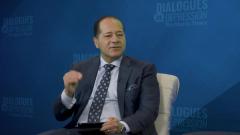
Targeting Glutamate Receptors in MDD Treatment
Experts continue their discussion on the role of glutamate receptors, explaining their role in stimulating neuroplasticity and neurogenesis.
Episodes in this series

Transcript
Gus Alva, MD, DFAPA: I’m really glad you touched on that point right now, Craig, because you’re absolutely right. We do utilize NMDA [N-methyl-D-aspartate] to be [a] separate antagonist for dementia, for probable Alzheimer disease. We know that too much glutamatergic activity will flood the postsynaptic neuron. And now you’ve got this enhanced apoptotic issue. So programmed cell death will ensue, which reminds us of the fact that we’ve got to have that fine balance of glutamate, right? I think one of the things that I wanted you [all] to opine on was the difference between say the NMDA receptor and the AMPA [α-amino-3-hydroxy-5-methyl-4-isoxazole propionic acid]
receptor because different studies have shown that, for example, ketamine, won’t necessarily work well unless AMPA receptors get involved, right? So, can you help our audience with that distinction of the difference between those glutamatergic receptors that we talk about?
Greg Mattingly, MD: Certainly. So, both AMPA and NMDA are glutamate receptors. They both open up that calcium ion channel and let it go inside the nerve cell, but they’re located in different areas of the brain. The NMDA receptor tends to be located on a GABA [γ-aminobutyric acid] interneuron, and so that GABA interneuron is able to modulate GABA glutamate firing. AMPA is sitting on the postsynaptic receptor, NMDA is there as well, but it directly turns on neural stimulation; it doesn’t modulate the GABA interneuron the way that the AMPA receptor does. So, both key receptors, they have to both work, they both have to be firing, but NMDA is kind of doing the fine tuning of your GABA networks at the same time.
Gus Alva, MD, DFAPA: Craig, you were commenting on AMPA receptors also and their downstream effects regarding other issues that help with synaptogenesis, neural sprouting and so on. Care to talk about that a little bit more?
Craig Chepke, MD, DFAPA: When the NMDA receptor that’s on that GABA interneuron is antagonized, it tends to lead to an increase of glutamate, and that glutamate is directed then to the AMPA receptor. So it’s actually increasing the amount of glutamate that gets to the AMPA receptor, and then the downstream changes from there is where kind of the magic happens. We’ve got theories, but it’s very complicated. BDNF [brain-derived neurotrophic factor] comes into play here…. The BDNF then gets released from the postsynaptic neuron, which is contrary to what most of us were taught in school, that we always release neurotransmitters from the presynaptic neuron. BDNF is released postsynaptically, binds to the TrkB [tyrosine receptor kinase B], and then from there it goes down into the mTOR [the mammalian target of rapamycin], and mTOR we think may be the final common pathway to then go on and stimulate the neuroplasticity from there. So it all comes around in a circular nature, but eventually leads down into mTOR, and then that’s where we think we see the neurogenesis starting.
Greg Mattingly, MD: The exciting part of our field right now is I’m listening to Craig talk. We have medicines that are currently being studied, you’re studying them as well, Gus, that hit each and every one of those pathways. So we have NMDA receptor modulators. We already have them there, but there’s other ones in development. We have AMPA receptor modulators. We have mTOR receptor modulators. We have TrkB receptor modulators, but that’s all they do and we’re testing them in a variety of mental health conditions right now.
Gus Alva, MD, DFAPA: You can’t also not speak about the inactivation of different things like GSK3 [glycogen synthase kinase 3] and other things that might be tied in with inflammatory responses, which we know are going to be harmful for the brain as well. So it’s really an interesting interplay because it sounds like a simplistic situation, but it’s quite complex. But it also offers the opportunity for additional targets down the line, as Greg makes mention [of] right now. And it’s an exciting time to be in this field right now. The fluidity allows us the opportunity to be able to actually do a bit more for our patients. And the interesting thing is just discovery, right? Who’d have thunk it? But, [from the] 1980s, moving from an amino acid to now, again, a neurotransmitter, main excitatory neurotransmitter, which is what we’re speaking about right now.
Transcript was AI-generated and edited for clarity.
Newsletter
Receive trusted psychiatric news, expert analysis, and clinical insights — subscribe today to support your practice and your patients.




























